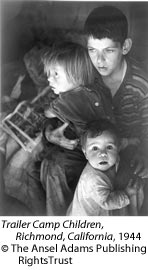|
Trailer Camp Children, Richmond, California,
1944
Plate 50 in Ansel Adams - Classic Images
Source: Chapter 17, Documentary Photography in Ansel Adams - An Autobiography
pp 257- 269 (See Bibliography under
Resources.)
A. What Do You See in This Photograph?
B. Did Adams often Take Photographs Like This?
C. Why Did Adams take Documentary Photography?
D. Is Trailer Camp Children Art?
E. What Was His Most Well-Known Documentary?
F. Did Adams Dislike Documentary Photography?
G. Related links in this site
A. What Do You See in This Photograph?
- How old are these children?
- Where are their parents?
- What would it be like to live in a trailer?
- Do you think the children are hungry or not? Why?
- What details do you notice?
- Choose one child; what would he or she be thinking?
...back to top
B. Did Adams often Take Photographs Like This?
This is an unusual photograph for Ansel Adams, who is known for
his images of nature. Yet he was outspoken in his political views. In
1983, Adams told an interviewer:
American society has "consistently overlooked the enormous
importance of the farmer, the technician, the educator, the artist,
and the laborer...I'm calling for greater equality to all citizens."
...back to top
C. Why Did Adams take Documentary Photography?
Documentary photography was very popular in American in the middle
of the 20th century. In the 1930s Life magazine started and "helped
expand the photograph as document into full visual essays with heart
and social intention, nourishing the new American photo-journalist."
In 1934 Adams met Margaret Bourke-White, one of the most successful
photographers with Life magazine. Adams needed to do commercial
photography in order to make a living, and most of his assignments came
from Life or Fortune Magazine.
Adams partnered with Dorothea Lange for a number of stories. She had
become well-known for her "great" photograph, Migrant Mother,
Nipomo, California, 1938, which Adams considered compelling because
of its art and documentary value. Lange was working as a photographer
in the Farm Security Administration (FSA) project during the Depression.
One joint assignment with Lange for Fortune was on the agricultural
situation in San Joaquin Valley of California. They were instructed
to stress agribusiness, but Dorothea depicted the far less privileged
small farmer, while Adams was "left with the large farms and the
corporate spirit." Afterwards he had a clearer vision of the struggle.
Always sensitive to nature, he said, "over exploitation will exhaust
our soil and water and is certain to impoverish California..."
...back to top
D. Is Trailer Camp Children Art?
Photographs of people are a small part of the work for which Adams
is most known. Here in this portrait of transient children, he reveals
his social conscience. Although an image with political ramifications,
Adams used his knowledge of art to capture moving expressions, organize
the composition, and visualize the range gray tones.
...back to top
E. What Was His Most Well-Known Documentary?
Adams took pictures of the Japanese-Americans detained during World
War II in the Manzanar Relocation Center in California . He published
a book in 1944, Born Free and Equal, with his photographs and
text critical of the detention. "I was profoundly affected by Manzanar."
He found it very disturbing, but chose to emphasize the "admirable
strength of spirit of the Nisei." Born Free and Equal was
his first attempt at "the photographic essay" (telling the
story with images). Adams found the form to be "the most complex
task in (his) professional career."
...back to top
F. Did Adams Dislike Documentary Photography?
For Adams the form had limitations. In a letter to Dorothea lange
in 1962, he wrote, "The connotations of much of documentary photography
are - to me - quite rigid...I resent being told that certain things
have significance...I resent the implications that unless photography
has a politico-social function it is not of value to people at large.
I resent the very obvious dislike of elements of beauty." Adams
praised Lange as a "fine artist" which he said was "more
important to the world than being merely an extension of a sociological
movement."
...back to top
G. Related links in this site
- Lesson Plans:
- Resources:
- See Bibliography for more material
by and about Ansel Adams. For more information on the technical
aspects - cameras, films, lenses, filters, darkroom techniques,
printing, papers, etc. - please refer to Examples, The Making
of 40 Photographs by Ansel Adams (Boston, Toronto, London:
Little, Brown and Co, 1983).
- About Photography
- See Glossary for definitions
of vocabulary words and photography terms.
|
